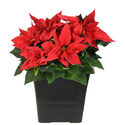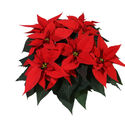Gardener's Grove: Poinsettias
National Poinsettia Day was Dec 12
December 19, 2019
No matter how soon retailers start pushing holiday deals, nothing says Christmastime quite like a poinsettia.
Wrapped in its foil, the poinsettia’s deep green leaves are topped with a smattering of bright red foliage.
Poinsettias (Species: Euphorbia pulcherrima) are as deceptive as they are festive. While they appear to be flowers with blooms, they are actually plants with bracts—colorful leaves, which makes sense because blooms are too delicate for winter conditions. Even the bracts are prone to chills.
To ensure healthy poinsettias upon arrival, cover with a cloth for transportation. Temperature fluctuations more than ten degrees in either direction will stress them out. We can all agree that stressors are best avoided this time of year.
Initially cultivated by the Aztecs, poinsettias made their way to the US when diplomat Joel Roberts Poinsett sent samples back to his greenhouses in South Carolina in the 1820s.

Today there are hundreds of cultivated varieties.
Left to their own devices, poinsettias tend to look more weed-like than the full, gathered forms we’re used to. The transition was made possible by the Ecke family, who until the 1980s held a near monopoly on the plants.
Albert Ecke, who emigrated to Los Angeles from Germany in 1900 opened a dairy and orchard and sold poinsettias alongside produce at roadside stands.
His son, Paul Ecke, developed the grafting technique that consistently produced a fuller, more compact plant. The Eckes’ technique made it possible to get every seedling to branch.
Then his son, Paul Eck, Jr., whose business prowess was in promotion, set to work associating poinsettias with Christmas by sending free samples to television stations that used the plants in their set decor.

This very effective product placement campaign put the poinsettia on the map, so to speak.
The burgeoning air mail industry helped to ensure that more specimens would arrive alive.
Each year in the US, approximately 70 million poinsettias are sold in a period of six weeks, at a value of about $250 million.
In the late 1980s, university researcher John Dole discovered the Eckes’ grafting technique and published it, allowing competitors to flourish. That, combined with the low cost labor found in developing countries, Paul Ecke III, new leader of the family business, decided to cease production in the US. Yet even as of 2008, they still served about 70 percent of the domestic market and about 50 percent worldwide.

Following a marketwide consolidation trend, the Ecke family sold the company in 2012. In an interview with Patch, Paul Ecke III stated that the business, family name, and all its employees both in America and Guatemala would be taken on by the new owners in a bittersweet farewell.
The poinsettias live on, both figuratively and literally. They are, after all, perennials that return year after year if treated right. Regular maintenance will keep the plant alive, but it is considered advanced level gardening to bring a poinsettia back into “bloom” in following years.
Regular maintenance:
Display poinsettias in indirect light for about six hours per day.
Maintain room temperatures at 60 to 70 degrees during the day, and 55 degrees at night to simulate their ideal natural habitat.

Water when the soil is dry to the touch. If you’re prone to overwatering, use a probe to determine root moisture levels. If you keep the plant in foil, puncture the bottom to allow drainage. Poinsettias are prone to root rot if left waterlogged.
Feed blooming poinsettias every two to three weeks with water-soluble plant food.
Coaxing a poinsettia to bloom again and again is exhausting. Each month the plant must be snipped or repotted, or moved to the dark, or moved to the light, watered or not watered—the process is a little extra to say the least.
For rebloom:
January-April: continue routine maintenance, offering the poinsettia plenty of light and enough water to stay moist, but not soggy.
April: prune plant to 6-8 inches
May: repot with fresh soil
June: move the poinsettia outdoors where it can get 6-8 hours of direct sunlight, fertilizing weekly. If placed in a garden bed, the plant must be lifted and turned weekly to prevent root shock when returned to the indoors later.
Late July: Prune the top of the plant and 2-3 leaves on each stem to keep the poinsettia from growing too leggy.
September: bring the poinsettia indoors when overnight temperatures fall into the low 50s.
October 1-Thanksgiving: forcing the bracts to color requires a controlled environment. Keep in uninterrupted darkness from 5 p.m. to 8 a.m. and then return to bright sun for the rest of the day. There should be a 7-10 degree difference between the dark and light environments; optimally, 65-70 degrees at night, and 70-80 degrees during the day. Fertilize weekly.
Thanksgiving: as the color transformation begins, suspend the dark-light routine, keeping the plant in a sunny spot for 6-8 hours daily. Once full color is achieved, stop fertilizing and move the poinsettia to where it is best admired. Congratulations!
Disease:
Poinsettias are susceptible to several diseases, mostly fungal, but also bacterial and parasitic. Conditions that promote poinsettia propagation also favor certain diseases. Fungal diseases affecting greenhouse poinsettia operations include Pythium root rot, Rhizoctonia root and stem rot, black root rot, scab, powdery mildew, and Botrytis blight. Bacterial diseases include bacterial soft rot and bacterial canker, while viral diseases are poinsettia mosaic virus. Most diseases stem from overwet roots, which is a problem easily avoided. Water with caution.

Reference: https://en.wikipedia.org/wiki/Poinsettia







Reader Comments(0)